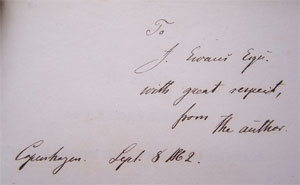Dansk Oldtid: Denmark and the development of European prehistory
|
'Any country which takes itself seriously ought to know about its own past.' (J.J.A. Worsaae, quoted in Stine Wiell, A letter from Line: the Flensburg antiquities and the Danish-Prussian/Austrian war of 1864, Antiquity 70 (1996) 270) The concept of chronological development of material culture, upon which the science of prehistory was to be developed, was originally developed in Scandinavia. The key concept was that of the 'Three-Age System', first formally developed by the Danish scholar and museum director, C.J. Thomsen in 1836 (Ledetraad til Nordisk Oldkyndighed, English edition 1848). In 1843 it was applied convincingly by his successor J.J.A. Worsaae to Danish and Nordic material (English edition published in 1849 as Primeval Antiquities of Denmark). |
|
|
Worsaae had presented the theory at meetings of antiquarian societies in the British Isles in 1846-7, following which a number of British scholars corresponded with him and incorporated his ideas in their own work. Subsequent correspondence between Worsaae and Evans reveals the mutual respect in which the two men held each other and the manner in which the dialogue between them both inspired and resulted in the refinement of the 'Three-Age System' which became universally accepted. |
Worsaae and other Scandinavian scholars within Evans's intellectual network had awakened an interest in the indigenous antiquities of Northern Europe at a time when the field of antiquarianism remained essentially focused on the classical world. This work in Northern Europe was inextricably linked to the development of the 'modern museum', which grew from the traditional and more disparate 'cabinet of curiosities'. The displays by Thomsen at the National Museum of Denmark, Copenhagen pioneered the development of the 'modern museum' and provided inspiration for new displays in Britain. The recognition of the importance of national antiquities in time also led to the provision of general antiquities legislation, including the protection of national monuments in Denmark. The Danish example and the concept of Danefæ was followed by similar initiatives in other European countries, including Britain in the early 1880s. |
|
Further References / Links: |
|

